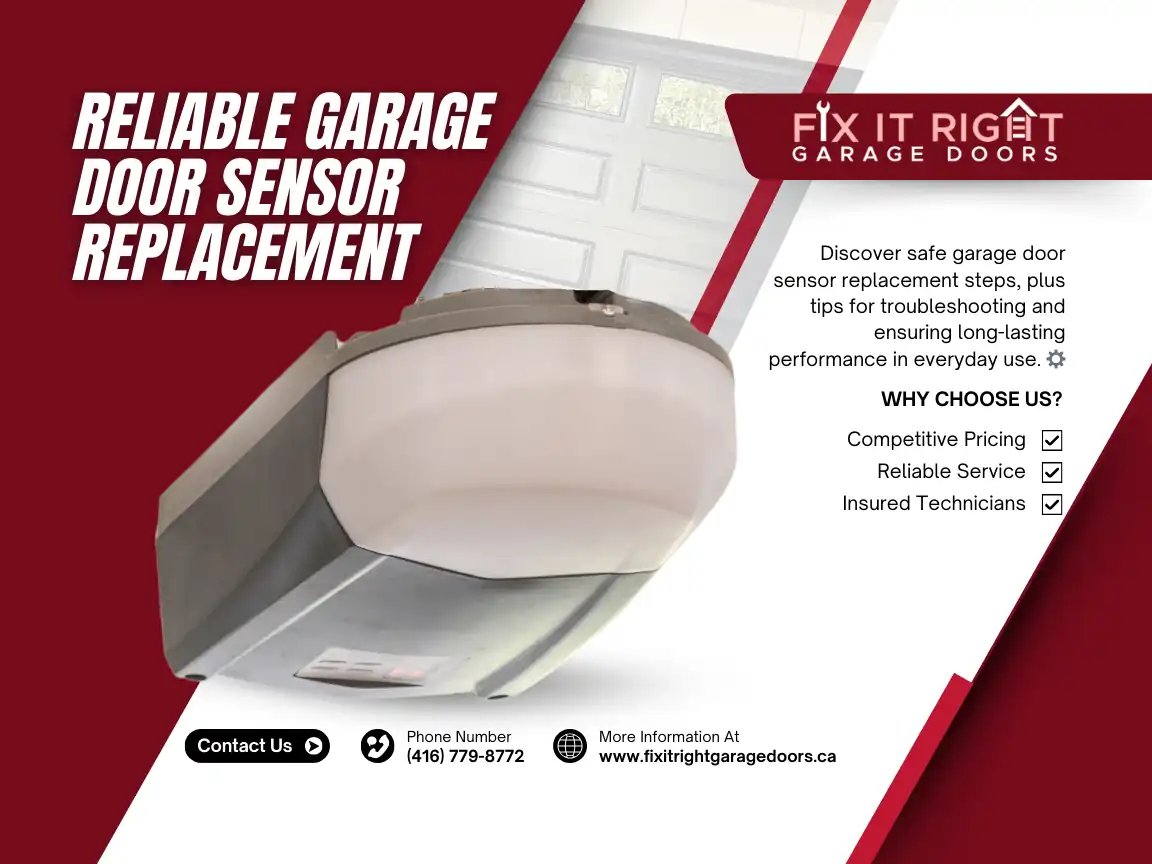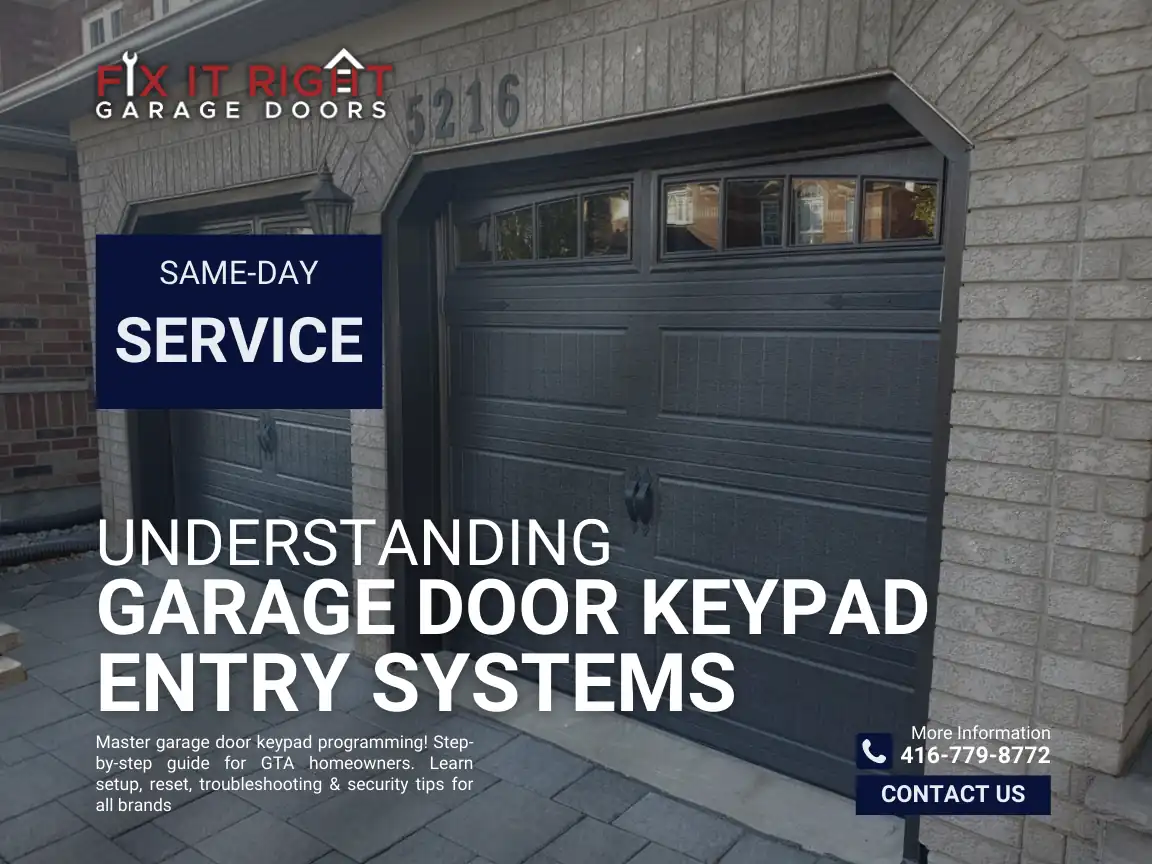When to replace Garage door sensors
If your garage door has been acting up—stopping midway, reversing without reason, or refusing to budge—you may be facing an issue with its safety sensors. These small but vital components detect obstructions and prevent accidents, making them a top priority for secure operation. When they fail, garage door sensor replacement becomes a pressing concern. In this guide, we’ll explore everything from key signs of sensor trouble to choosing the right replacement solutions, whether you decide to DIY or call in the pros. ⚡
Below is a quick table that highlights common warning signs of faulty sensors. Keep an eye out for these red flags so you can plan for any repairs:
| Symptom | Possible Cause |
|---|---|
| The door reverses immediately after closing | Sensor misalignment or blocked signal |
| Steady or blinking sensor lights | Wiring issues, dust on the lens, or internal sensor failure |
| The door stops randomly during operation | An inconsistent signal caused by damaged sensors |
| No light from either sensor | Power supply problem or completely fried sensor circuit |
| The door only closes when holding the wall button | Sensor override is in effect due to a safety system malfunction |
Knowing these signs allows you to address sensor issues fast, ensuring the door operates smoothly. After all, a malfunctioning sensor system isn’t just an inconvenience—it’s a safety hazard. Let’s dive into the details of this essential topic so you can feel confident tackling your garage door sensor replacement project.
Signs of Sensor Trouble
One of the most common indicators that your garage door sensors need attention is erratic door behavior. Maybe the door keeps reversing right before touching the floor, or it won’t close at all unless you hold the wall button down. Sometimes, sensor LED lights flicker or stay off completely. These signals often mean the sensors are misaligned, blocked, or at the end of their lifespan.
A homeowner once noticed their door refusing to close unless they manually held the button. After a quick inspection, they discovered the sensors were caked in dirt and slightly knocked out of alignment. A thorough cleaning and minor repositioning solved the issue. However, if cleaning and aligning the sensors don’t fix the problem, garage door sensor replacement could be your best bet for a reliable fix. ✨
Short-cycling—a situation where the door closes a bit and then reopens—can be particularly frustrating. It usually stems from sensors sending mixed signals to the opener. When that happens more than once or twice, it’s worth checking for damaged wires, corroded terminals, or a failing circuit board inside the sensor housing.


How Garage Door Sensors Work
Garage door sensors rely on an invisible infrared beam running between two units: a transmitter on one side of the door and a receiver on the other. When something (or someone) disrupts the beam, the system signals the opener to stop or reverse. This safety measure prevents accidents, safeguarding pets, children, and property. ⚙️
Below are some key points about sensor operations:
- Infrared Beam: Sensors project a beam at a specific height, usually around 6 inches from the floor.
- Transmitter & Receiver: One sensor sends the signal; the other receives it.
- Circuitry: Modern sensors have circuit boards for processing signals and alerting the garage door opener if anything disrupts the beam.
- Indicator Lights: These lights let you know whether the sensors are powered and aligned. Blinking or off lights might indicate an error.
Older sensors can degrade over time due to moisture, dirt, or electrical issues. If you find yourself constantly tinkering with alignment, it might be time for a garage door sensor replacement to ensure hassle-free performance.
When to Replace Garage Door Sensors
A crucial question many homeowners face is when to replace garage door sensors. While cleaning and alignment often restore normal function, a complete replacement may be more cost-effective if:
- The sensors have visible cracks or damage on the lens.
- Internal circuitry malfunctions cause erratic signals.
- Multiple repairs haven’t permanently fixed the issue.
- The manufacturer no longer supports or produces compatible parts.
One family noticed their 15-year-old sensor giving out random signals, causing the door to reverse unexpectedly. They’d tried every fix: rewiring, realigning, even replacing brackets. Nothing worked for long. Upgrading to a modern sensor system cured the problem instantly and provided fresh safety features, like improved infrared detection. Sometimes, an upgrade beats the headache of endless repairs. ⚡
Additionally, if your garage door opener is already undergoing a major overhaul, like a new motor or a belt-drive conversion, it’s smart to include a garage door sensor replacement in the project. This holistic approach ensures all components are equally up-to-date, saving you from having to schedule another repair call down the road.
Common Causes of Sensor Failure
Several culprits might be behind your sensor troubles. Dirt and debris are top offenders, especially in dusty or high-traffic garages. Moisture can also creep in if the sensor housing isn’t watertight. And of course, general wear and tear is unavoidable over the years. Sometimes, pets or kids bump into the sensors while playing, misaligning them just enough to break the infrared beam.
Below is a table showing typical causes of sensor failure alongside possible fixes:
| Cause | Typical Solution |
|---|---|
| Dirt or grime | Gentle cleaning with a soft cloth & mild cleaner |
| Misalignment | Realign sensors until indicator lights stabilize |
| Damaged wires | Re-splice or replace wiring segments |
| Defective circuit | Full sensor replacement |
| Loose mounting bracket | Tighten screws or replace bracket |
If you’re consistently dealing with the same sensor problems, it’s likely time for a deeper inspection or a complete switch to new sensors. 🛠️
Tools & Safety Gear
Working on a garage door involves more than just a screwdriver. Sensors are at the base of the door tracks, meaning you’ll be crouching down, possibly in tight spaces, and handling small components. Here are some essentials for a safe, smooth garage door sensor replacement:
- Protective Eyewear and Gloves: Prevent dust, debris, or sharp edges from causing injuries.
- Phillips & Flat-Head Screwdrivers: For removing sensor brackets or terminals.
- Wire Strippers & Cutters: In case you need to re-splice or replace sensor wiring.
- Level: To ensure accurate alignment.
- Extra Screws & Mounting Hardware: Sometimes, old brackets break during removal.
If your existing wiring is corroded or frayed, you may also want to have extra wire on hand. A stable flashlight or headlamp helps illuminate the sensor area, especially in dimly lit garages.
DIY Garage Door Sensor Replacement Tips
If you’re comfortable with basic tools and wiring, tackling DIY garage door sensor replacement tips can save some money. Just remember to unplug the garage door opener before starting to avoid accidental operation. ⚠️
Here’s a quick rundown of the DIY process:
- Power Off: Unplug the garage door opener or turn off the circuit breaker.
- Remove Old Sensors: Unscrew brackets, disconnect wires, and gently detach the sensor units.
- Wire Prep: Strip about half an inch of insulation off the existing wires, ensuring a clean copper end.
- Install New Sensors: Mount them at the same height as your old ones. Most new sensors come with color-coded wires that match existing leads.
- Align & Secure: Use a level to line up both sensors; secure them with brackets or screws.
- Restore Power & Test: Plug the opener back in, test the door’s response, and verify that sensor LEDs are stable (not blinking).
If the door closes without reversing randomly and stops when an object crosses the beam, congratulations—you’ve done it! However, if the lights still blink or the door refuses to budge, double-check your wiring and alignment before concluding that something else is to blame.
Best Garage Door Sensor Replacement Solutions
There are plenty of sensor models on the market, but not all are created equal. Some brands offer advanced features like self-aligning technology or built-in diagnostic LEDs that pinpoint errors more accurately. When searching for the best garage door sensor replacement solutions, consider:
- Brand Compatibility: Sensors must match the frequency and logic board design of your opener.
- Warranty Coverage: A solid warranty can offer peace of mind, especially if you live in areas with harsh weather.
- Durability: Weatherproof or water-resistant casings are crucial if your garage is prone to moisture.
- Installation Ease: Models with simple wiring and universal bracket systems can save time and headaches.
Homeowners who upgrade to premium sensors often appreciate features like auto-calibration, which can save you from fussing with manual alignments. Others enjoy extra mounting flexibility, making it easier to place sensors high enough to avoid accidental knocks from kids or pets. Ultimately, the best sensor replacement depends on your door’s brand, your budget, and how often you plan to operate the door every day.
Professional Garage Door Sensor Replacement Services
While a do-it-yourself approach can work, not everyone has the time or inclination to handle sensor replacements. That’s where professional garage door sensor replacement services step in. Skilled technicians bring specialized tools and deep experience to diagnose, replace, and calibrate sensors correctly on the first try. They also spot other lurking issues—like fraying cables or worn-out rollers—that you may overlook.
A homeowner who recently updated their old sensors through a professional service noticed the door operating more quietly and smoothly afterward. The technicians discovered slight track misalignment and replaced a few rusted bolts along with the sensors. This comprehensive approach prevented potential problems down the line. ⚡
If you’re short on time or uneasy about electrical work, hiring a pro can be well worth the investment. Reputable companies typically provide warranties on both parts and labor. Should anything go wrong within that warranty period, they’ll fix it without extra charges. For trusted local help, consider Fix It Right Garage Doors. They can handle your sensor replacement safely and efficiently, leaving you with a door that operates at peak performance.
Maintenance for Long-Lasting Sensors
Once you’ve nailed your garage door sensor replacement, a little care keeps them working for years. Simple tasks like wiping off dust or spiderwebs from the lenses can prevent faulty readings. Checking for stable brackets every few months helps ensure the sensors remain aligned. Below are some quick pointers for sensor upkeep:
- Gently clean the lens with a soft cloth (no harsh chemicals).
- Confirm the mounting brackets are still tight, especially if you have kids or pets.
- Ensure wires remain free from corrosion or accidental damage.
- Keep an eye on indicator lights; blinking signals misalignment or obstruction.
Don’t forget to schedule periodic checks of the entire door system. Lubricate hinges and rollers, inspect the tension springs, and test the auto-reverse function. This holistic approach ensures that new sensors remain in top shape and your garage door runs smoothly day in and day out. ✨
Conclusion
Dealing with sensor woes doesn’t have to be a drawn-out drama. Whether you’re experiencing abrupt reversals, stubborn doors that won’t close, or sensor lights blinking like crazy, garage door sensor replacement is often the surest path to a safe, hassle-free fix. From recognizing the warning signs to selecting the right equipment and installing it properly, each step gets you closer to a door that behaves exactly as it should.
Maintaining your sensors goes hand in hand with overall garage door health. A well-tuned system means no unexpected malfunctions at the worst possible time, like a hectic morning when you’re already late for work. ⚙️
❓ Have you noticed flickering sensor lights or a door that refuses to close?
❓ Do you feel prepared to handle wiring tasks yourself, or would professional expertise give you more peace of mind?
❓ Could high-end sensors with auto-alignment features make your daily routines smoother?
If you’re uncertain or pressed for time, consider reaching out to specialists. A reputable contractor, like Fix It Right Garage Doors, will get your garage door sensors back on track quickly. For further reading on safety standards and best practices, check out this external resource, which offers a wealth of home improvement insights.
Making a sensible decision about garage door sensor replacement pays off in boosted safety, convenience, and peace of mind. With a proactive approach and regular checkups, you’ll ensure your sensor system stays reliable for years to come. ⚡










